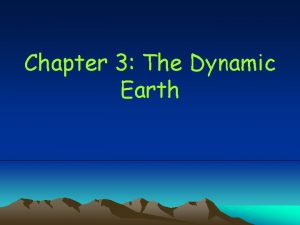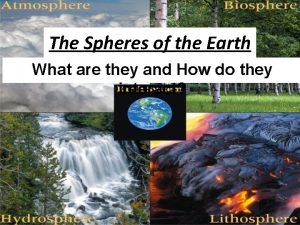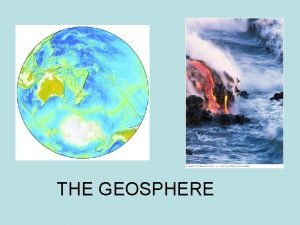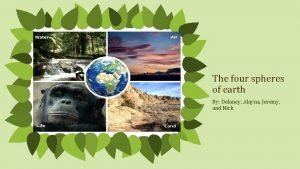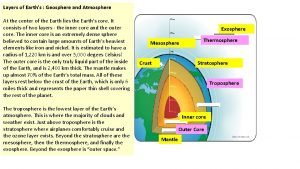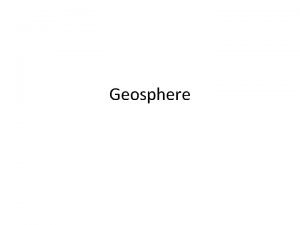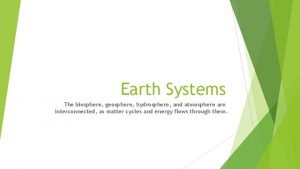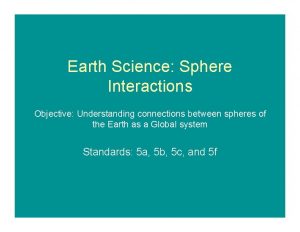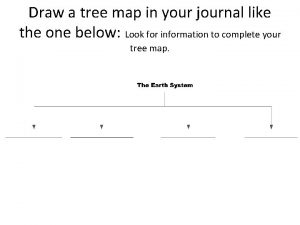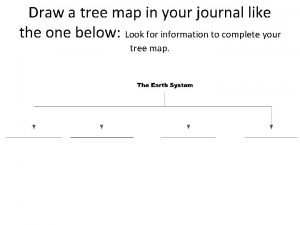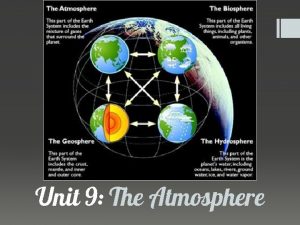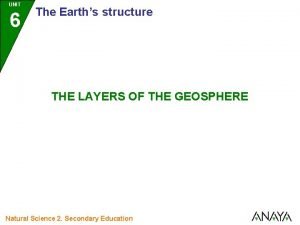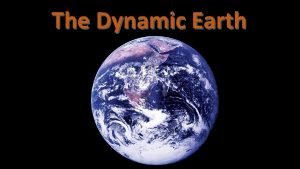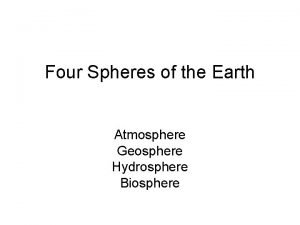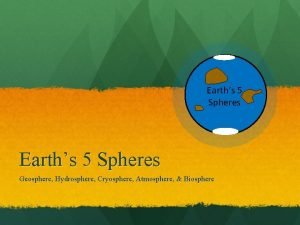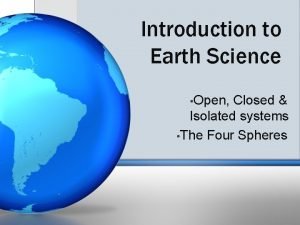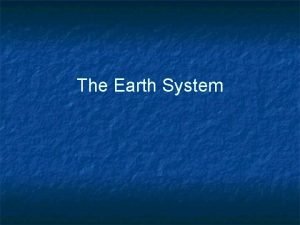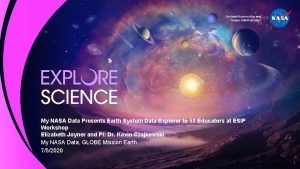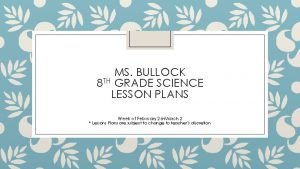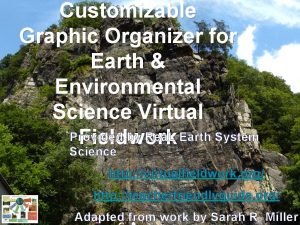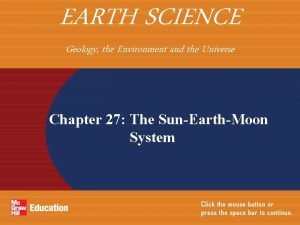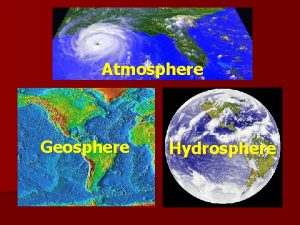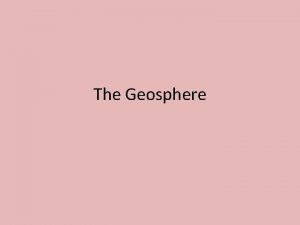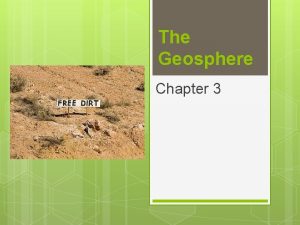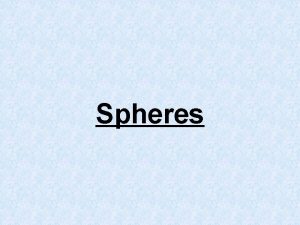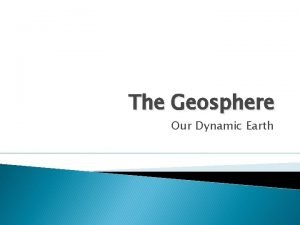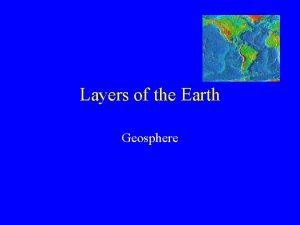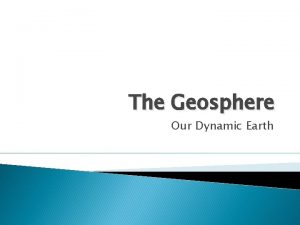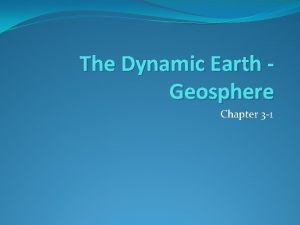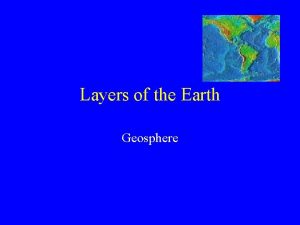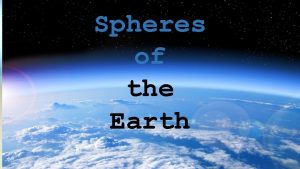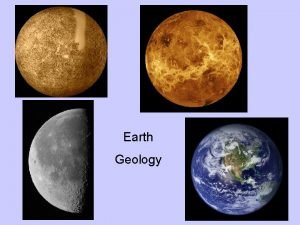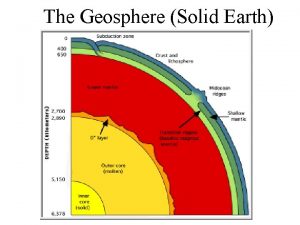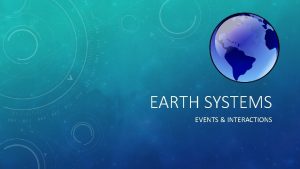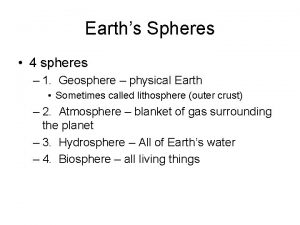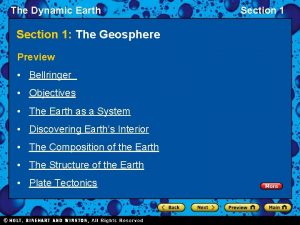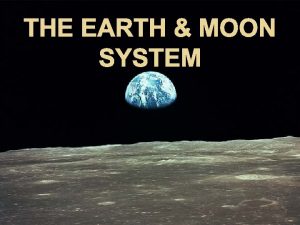The Geosphere The Earth as a System The

























- Slides: 25

The Geosphere

The Earth as a System The Earth is a system of 4 interacting components. Consists of: - Geosphere - Atmosphere - Hydrosphere - Biosphere

The Geosphere Composition • The solid part of the Earth (rocks, minerals, soil, etc. ) – Most of the geosphere is below the surface What is it? Lithosphere Cool, rigid layer that includes the crust; divided into plates Asthenosphere Flexible layer of the mantle that flows slowly, allowing plates above it to move Outer Core Liquid nickel and iron Inner Core Solid nickel and iron

• Look at the world map. Does anything look like it could fit together like a puzzle?

The Geosphere Plate Tectonics Pangaea – Wegener’s idea that all of Earth’s continents were joined into one giant landmass 200 million years ago.

The Geosphere Plate Tectonics • The tectonic plates ride atop the asthenosphere, moving in different directions Boundary Movement Convergent 2 plates move together Divergent Transform Result Mountains, volcanoes, earthquakes

Convergent Plate Boundaries Continental-continental Oceanic- oceanic Oceanic-continental

The Geosphere Plate Tectonics • The tectonic plates ride atop the asthenosphere, moving in different directions Boundary Movement Convergent 2 plates move together Divergent 2 plates move apart Transform Result Mountains, volcanoes, earthquakes Ocean ridges (volcanic), rift valleys, earthquakes

Divergent Plate Boundaries Mid-ocean ridge Rift Valley

The Geosphere Plate Tectonics • The tectonic plates ride atop the asthenosphere, moving in different directions Boundary Movement Convergent 2 plates move together Divergent 2 plates move apart Transform 2 plates slide past each other Result Mountains, volcanoes, earthquakes Ocean ridges (volcanic), rift valleys, earthquakes Faults, earthquakes

Transform Plate Boundaries

The Geosphere Plate Tectonics Global Earthquake Distribution Global Volcano Distribution

The Geosphere Earthquakes Volcanic Eruptions How does it Earth’s crust slips happen? along a fault (crack in the crust) Local Effects Destruction, injuries, death Global Effects Tsunamis Which of these geologic hazards poses the greatest threat to the environment? Why?


The Geosphere Earthquakes Volcanic Eruptions How does it happen? Earth’s crust slips along a fault (crack in the crust) Pressure of magma inside the volcano becomes so great that it blows open the solid surface. Local Effects Destruction, injuries, death, mudflows, *improved soil fertility Global Effects Tsunamis Ash clouds from major eruptions can block sunlight & change drop the average global temp.

The Geosphere Erosion • Rocks on the surface are changed by wind, running water, and weather. • Erosion is the removal and transport of weathered surface materials. • Over long periods of time, erosion can wear away entire mountains and produce spectacular landforms.

The Land How is the land in this picture being used?

How We Use Land Urban land = land covered mostly with buildings & roads and containing 2500 or more people. Rural land = land containing few people & large areas of open space.

Think-Pair-Share How are each type of land cover important to people?

The Urban-Rural Connection Think About It… Are people dependent on the resources produced in rural areas? Ecosystem services – resources produced by natural & artificial ecosystems

Development of Marginal Lands • Some suburbs have been built on land that is not well suited to support buildings. • This land is prone to landslides because it is unstable – Ex: Los Angeles, Mexico City

Urban Environmental Condition Heat Islands – increased temperature in a city Why? - roads & buildings absorb more heat than vegetation Effects? – local weather patterns change, more rainfall in cities Pollution of air, water, & land

Urban Planning • Land-use planning is essential for pleasant urban living experiences. • Ex: – Transportation in cities involves mass transit systems (buses, trains) • Mass transit saves energy, reduces traffic, lowers air pollution, & limits the loss of land to roads & parking lots – Open space is set aside in urban areas for recreational enjoyment (parks, gardens, bike paths, hiking trails) • Open spaces absorb CO 2, produce oxygen, filter pollutants, lower temperatures, absorb rainwater

Land Management & Conservation Land Type Farm land Range land Forest land Parks & Preserves What is it? How is it used by people? What are the problems/threats to this land? How can it be maintained / protected? LAND USED FOR CROPS AND FRUITS FOOD URBAN DEVELOPMENT FARMLAND PROTECTION PROGRAM LAND THAT SUPPORTS VEGETATION (GRASSES) GRAZING LIVESTOCK OVERGRAZING PUBLIC RANGELANDS IMPROVEMENT ACT LAND THAT SUPPORTS TREES WOOD, LUMBER, PAPER, ETC. LAND PROTECTED AGAINST DEVELOPMENT RECREATION, WILDLIFE REFUGE, PROTECTING ENDANGERED SPECIES DEFORESTATION REFORESTATION (CLEARING WITHOUT REPLACING) INCREASED DEVELOPMENT, VISITOR DESTRUCTION & LITTERING US WILDERNESS ACT – PROTECTS FROM EXPLOITATION

Designing A Community • You are a land-use planner. Design a model community that is to be home for 1000 people. Name your community & tell us where in the world you are located. – Sketch your plans for the following: • • • Housing Commercial Transportation routes Open spaces Community services (electricity, water, trash collection, police & fire protection, schools, hospitals, etc. ) • Where will resources come from?
 Chapter 3 the dynamic earth section 1 the geosphere
Chapter 3 the dynamic earth section 1 the geosphere Biosphere examples
Biosphere examples What is geosphere made of
What is geosphere made of Geosphere defintion
Geosphere defintion Layers of the geosphere
Layers of the geosphere Bill nye geosphere
Bill nye geosphere Geosphere and atmosphere
Geosphere and atmosphere Geosphere atmosphere hydrosphere and biosphere
Geosphere atmosphere hydrosphere and biosphere How do earth's spheres interact
How do earth's spheres interact Biosphere mind map
Biosphere mind map How to draw a tree map
How to draw a tree map Geosphere vocabulary
Geosphere vocabulary What is geosphere made of
What is geosphere made of Geosphere
Geosphere Geosphere diagram
Geosphere diagram Geosphere diagram
Geosphere diagram What is the geosphere
What is the geosphere What is biosphere and geosphere
What is biosphere and geosphere Geosphere
Geosphere Open closed isolated system
Open closed isolated system How can you compare the terrarium to an earth system
How can you compare the terrarium to an earth system Earth system data explorer
Earth system data explorer The sun-earth-moon system worksheet answers lesson 1
The sun-earth-moon system worksheet answers lesson 1 Earth system science graphic organizer
Earth system science graphic organizer Collab crib (2021) userscloud.com
Collab crib (2021) userscloud.com Chapter 27 study guide the sun-earth-moon system
Chapter 27 study guide the sun-earth-moon system
